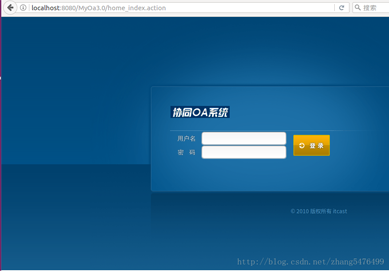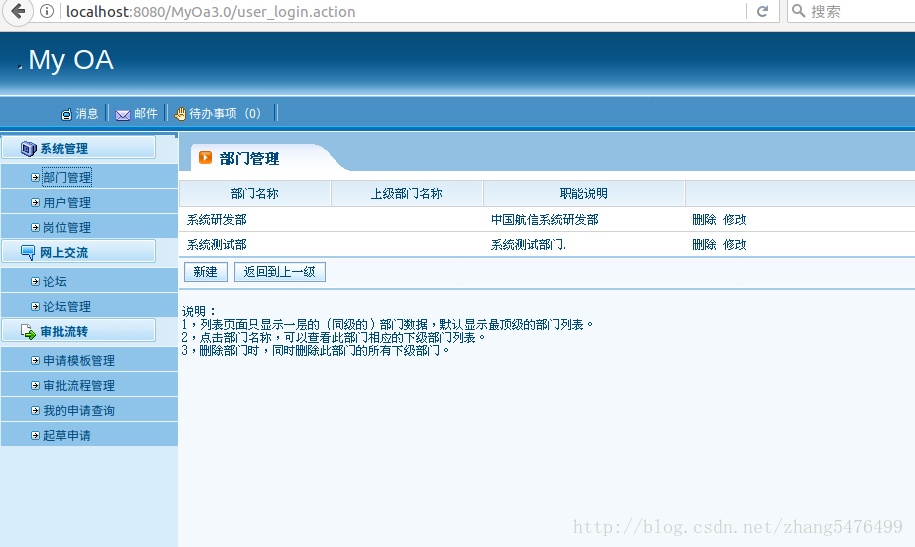Struts2攔截器的概念和Spring Mvc攔截器一樣。
1.Struts2攔截器是在訪問某個Action或Action的某個方法,字段之前或之后實施攔截,并且Struts2攔截器是可插拔的,攔截器是AOP的一種實現.
2.攔截器棧(Interceptor Stack)。Struts2攔截器棧就是將攔截器按一定的順序聯結成一條鏈。在訪問被攔截的方法或字段時,Struts2攔截器鏈中的攔截器就會按其之前定義的順序被調用。
使用攔截器的第一步:
自定義我的權限攔截器CheckPrivilegeInterceptor,這個攔截器繼承自AbstractInterceptor這個抽象類,當然你可以實現Interceptor這個接口。
|
1
2
3
4
5
6
7
8
9
10
11
12
13
14
15
|
import com.opensymphony.xwork2.ActionContext;import com.opensymphony.xwork2.ActionInvocation;import com.opensymphony.xwork2.interceptor.AbstractInterceptor;import com.shizongger.oa.domain.User;public class CheckPrivilegeInterceptor extends AbstractInterceptor { @Override public String intercept(ActionInvocation invocation) throws Exception { System.out.println("---攔截器未攔截之前---"); String result = invocation.invoke(); System.out.println("---攔截器攔截之后---"); return result; }} |
自定義的攔截器要覆蓋AbstractInterceptor抽象類的抽象方法intercept()方法,該方法是對所有的action進行攔截,String類型的返回值是我們將要返回的視圖,如果要放行我們要攔截的action地址,那么代碼如上所示。
使用攔截器的第二步:
配置struts的配置文件,主要是配置自定義的攔截器和配置攔截器棧。在struts.xml配置文件的package元素節點下添加以下配置:
|
1
2
3
4
5
6
7
8
9
10
11
|
<!-- 配置攔截器 --> <interceptors> <!-- 聲明攔截器 --> <interceptor name="checkPrivilege" class="com.shizongger.oa.util.CheckPrivilegeInterceptor"></interceptor> <!-- 重新定義默認的攔截器棧 --> <interceptor-stack name="defaultStack"> <interceptor-ref name="checkPrivilege"></interceptor-ref> <interceptor-ref name="defaultStack"></interceptor-ref> </interceptor-stack> </interceptors> |
啟動我的Tomcat服務器,當我在瀏覽器輸入我的action地址時,都會被該攔截器的intercept攔截,默認是放行的,如果返回空字符串則因找不到對應的視圖而報錯。
登錄和權限攔截
攔截器在Web開發中應用場景最多的地方就是登錄驗證和權限驗證了。對于那些未登錄系統的用戶,一般我們都把他所有的請求打回到登錄頁面。而對于那些已經登錄系統的用戶,如果你不具有相應的權限,那么將無法訪問我們的url。
首先在監聽器中最一些系統做一些監聽任務。
|
1
2
3
4
5
6
7
8
9
10
11
12
13
14
15
16
17
18
19
20
21
22
23
24
25
26
|
public class MyServletContextListener implements ServletContextListener { Log log = LogFactory.getLog(this.getClass()); @Autowired private PrivilegeService privilegeService; @Override public void contextDestroyed(ServletContextEvent sce) { log.debug("---銷毀監聽器---"); } @Override public void contextInitialized(ServletContextEvent sce) { ServletContext sc = sce.getServletContext(); ApplicationContext ac = WebApplicationContextUtils.getWebApplicationContext(sc); PrivilegeService privilegeService = (PrivilegeService) ac.getBean("privilegeServiceImpl"); List<Privilege> topPrivilegeList = privilegeService.findTopList(); //將權限list放到比application作用域還大的ServletContext sc.setAttribute("topPrivilegeList", topPrivilegeList); // 準備數據:allPrivilegeUrls Collection<String> allPrivilegeUrls = privilegeService.getAllPrivilegeUrls(); sc.setAttribute("allPrivilegeUrls", allPrivilegeUrls); }} |
監聽器的任務是從Web容器中獲得Spring的容器ApplicationContext,再從ApplicationContext中獲得權限服務類privilegeService,這個service主要作用有兩點,其一是獲得有多的頂級權限列表;其二是獲得所以權限列表。將這兩者放入到application里邊。
接下來就可以在我們的攔截器中寫登錄攔截的邏輯代碼了。
|
1
2
3
4
5
6
7
8
9
10
11
12
13
14
15
16
17
18
19
20
21
22
23
24
25
26
|
public String intercept(ActionInvocation invocation) throws Exception { //獲取信息,從session中取出當前登錄用戶 User user = (User) ActionContext.getContext().getSession().get("user"); String nameSpace = invocation.getProxy().getNamespace(); String actionName = invocation.getProxy().getActionName(); //對應的權限地址 String privilegeUrl = nameSpace + actionName; //如果未登錄 if(user == null) { //如果是去登錄的頁面和登錄請求,就放行 if("/user_login".equals(privilegeUrl)) { return invocation.invoke(); //否則跳轉到登錄頁面 } else { return "loginUI"; } } else { //如果已經登錄則判斷是否有權限 if(user.hasPrivilegeByUrl(privilegeUrl)) { return invocation.invoke(); } else { return "noPrivilegeError"; } }} |
處理的邏輯是,如果未登錄,則判斷是不是要去登錄,如果用戶正在登錄則放行,其他請求都要跳轉到loginUI登錄頁面。如果已經登錄,則判斷正在登錄的用戶是否具有相對應的權限。而判斷是否具有權限的方法在我的user.java里面。
|
1
2
3
4
5
6
7
8
9
10
11
12
13
14
15
16
17
18
19
20
21
22
23
24
25
26
27
28
29
30
31
32
33
34
35
36
37
38
39
40
41
42
43
44
45
46
47
48
49
50
51
52
53
54
55
56
57
58
59
60
61
62
63
64
65
66
67
68
69
70
71
72
73
74
75
76
77
78
79
80
81
82
83
84
85
86
87
88
89
90
91
92
93
94
95
96
97
98
99
100
101
102
|
/** * 用戶實體 * @author shizongger * @date 2017/03/24 */public class User { private Log log = LogFactory.getLog(this.getClass()); private Long id; private String loginName; private String password; private String name; private String gender; private String phoneNumber; private String email; private String description; private Department department; private Set<Role> roles; //getter/settter方法 /** * 判斷用戶是否用該權限 * @param privilegename 權限名稱 * @return */ public boolean hasPrivilegeByName(String privilegeName) { log.debug("權限名稱:" + privilegeName); //從本用戶中取出所有角色 for(Role role : roles) { //從角色遍歷出所有權限 Set<Privilege> privilegeList = role.getPrivileges(); for(Privilege privilege : privilegeList) { if(privilegeName.equals(privilege.getName())) { log.debug(privilegeName + "---有權限---"); return true; } } } log.debug(privilegeName + "---沒有權限---"); return false; } /** * 判斷本用戶是否有指定URL的權限 * * @param privUrl * @return */ public boolean hasPrivilegeByUrl(String privUrl) { // 超級管理有所有的權限 if (isAdmin()) { return true; } // >> 去掉后面的參數 int pos = privUrl.indexOf("?"); if (pos > -1) { privUrl = privUrl.substring(0, pos); } // >> 去掉UI后綴 if (privUrl.endsWith("UI")) { privUrl = privUrl.substring(0, privUrl.length() - 2); } // 如果本URL不需要控制,則登錄用戶就可以使用 Collection<String> allPrivilegeUrls = (Collection<String>) ActionContext.getContext().getApplication().get("allPrivilegeUrls"); if (!allPrivilegeUrls.contains(privUrl)) { return true; } else { // 普通用戶要判斷是否含有這個權限 for (Role role : roles) { for (Privilege priv : role.getPrivileges()) { if (privUrl.equals(priv.getUrl())) { return true; } } } return false; } } /** * 判斷本用戶是否是超級管理員 * * @return */ public boolean isAdmin() { return "admin".equals(loginName); }} |
hasPrivilegeByUrl()方法為根據url判斷用戶是否具有權限的代碼邏輯,此邏輯分為三部分。其一,如果登錄的用戶是超級管理員admin,則不用驗證權限,該用戶具有所有的權限。其二,如果登錄的用戶基本功能部分不用驗證,需要驗證的功能才需要驗證。基礎功能模塊比如首頁,退出,登錄頁面等都不要再驗證。
權限的service實現類如下:
|
1
2
3
4
5
6
7
8
9
10
11
12
13
14
15
16
17
18
19
20
21
22
|
@Servicepublic class PrivilegeServiceImpl extends DaoSupportImpl<Privilege> implements PrivilegeService { @Override @Transactional public List<Privilege> findTopList() { List<Privilege> topPrivletList = this.getSession() .createQuery("FROM Privilege p WHERE p.parent IS NULL") .list(); return topPrivletList; } @Override @Transactional public Collection<String> getAllPrivilegeUrls() { return getSession().createQuery(// "SELECT DISTINCT p.url FROM Privilege p WHERE p.url IS NOT NULL")// .list(); }} |
未登錄的狀態直接輸入主頁面將自動彈回登錄頁面,如圖所示

在登錄狀態下權限如圖:

以上就是本文的全部內容,希望對大家的學習有所幫助,也希望大家多多支持服務器之家。
原文鏈接:http://www.cnblogs.com/shizongger/p/6809021.html















